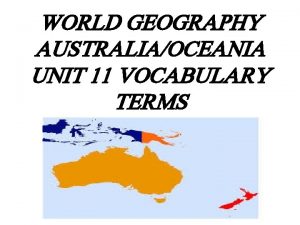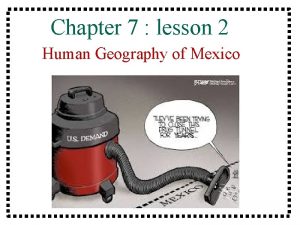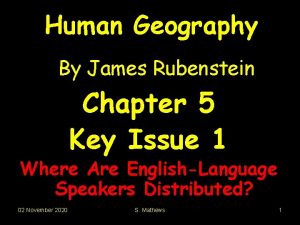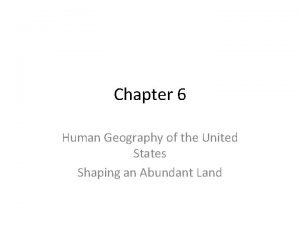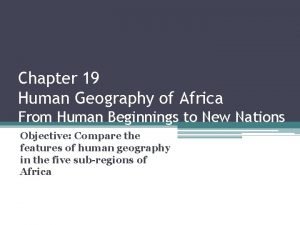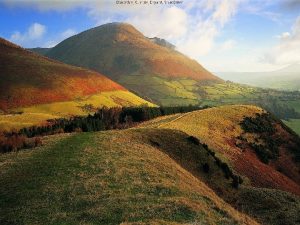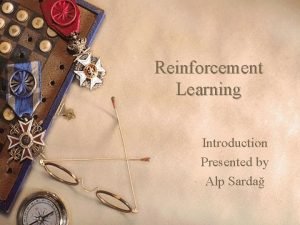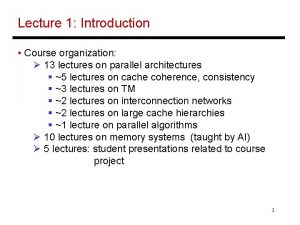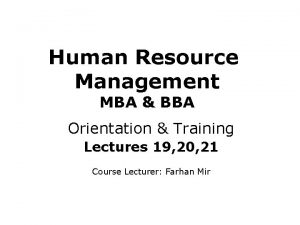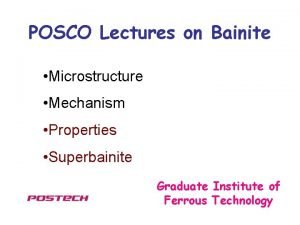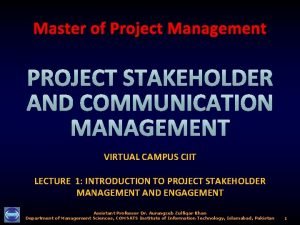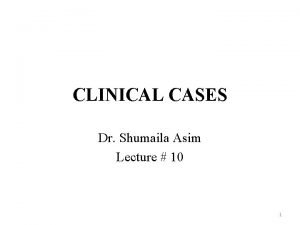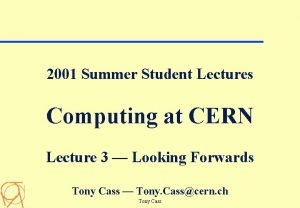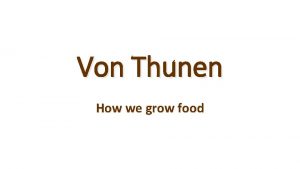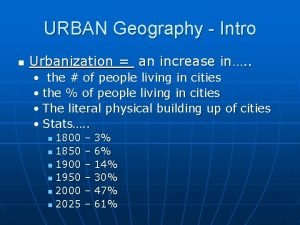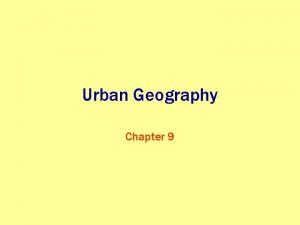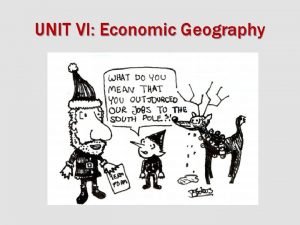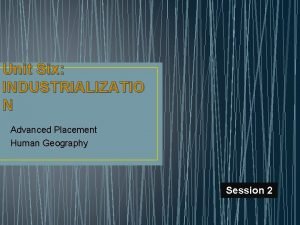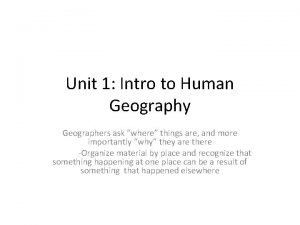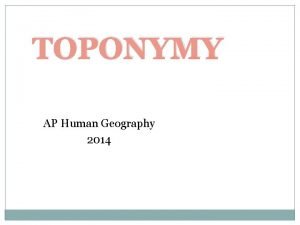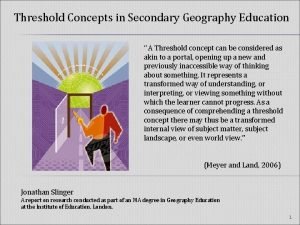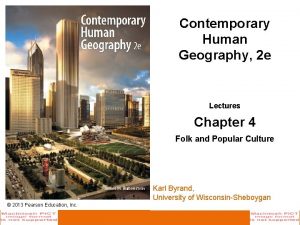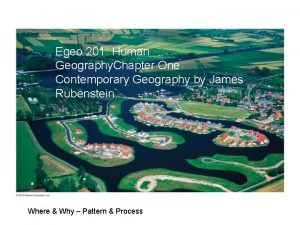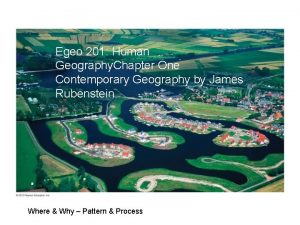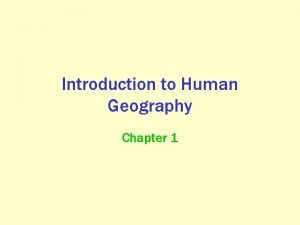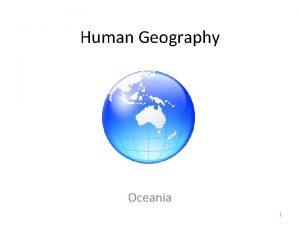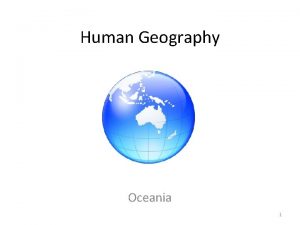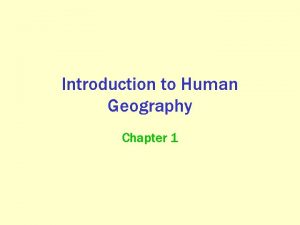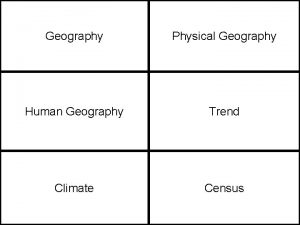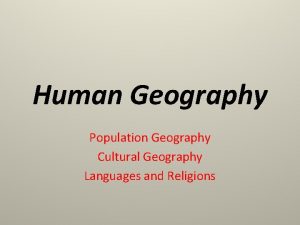Contemporary Human Geography 2 e Lectures Chapter 10

























































































- Slides: 89

Contemporary Human Geography, 2 e Lectures Chapter 10 Food and Agriculture Karl Byrand, University of Wisconsin-Sheboygan © 2013 Pearson Education, Inc.

10. 1 ORIGIN OF AGRICULTURE • Agriculture • Deliberate modification of Earth’s surface through cultivation of plants and rearing of animals to obtain sustenance or economic gain • Crop • Any plant cultivated by people © 2013 Pearson Education, Inc.

10. 1 ORIGIN OF AGRICULTURE • Hunters and gatherers • Small groups • Male–female division of labor • Daily food gathering • Mobility • Only ~250, 000 today © 2013 Pearson Education, Inc.

10. 1 ORIGIN OF AGRICULTURE HUNTERS AND GATHERERS © 2013 Pearson Education, Inc.

10. 1 ORIGIN OF AGRICULTURE • Crop hearths • Early centers of domestication © 2013 Pearson Education, Inc. CROP HEARTHS

10. 1 ORIGIN OF AGRICULTURE • Animal hearths © 2013 Pearson Education, Inc.

10. 1 ORIGIN OF AGRICULTURE • Why agriculture originated • Environmental factors • Cultural factors © 2013 Pearson Education, Inc.

10. 2 DIET • Factors affecting food consumption • Level of development • Physical conditions • Cultural preferences • Total consumption of food • Kilocalories • Most derived from grains © 2013 Pearson Education, Inc.

10. 2 DIETARY ENERGY BY SOURCE © 2013 Pearson Education, Inc.

10. 2 DIET WHEAT CONSUMPTION © 2013 Pearson Education, Inc.

10. 2 DIET RICE CONSUMPTION © 2013 Pearson Education, Inc.

10. 2 DIET MAIZE CONSUMPTION © 2013 Pearson Education, Inc.

10. 2 DIET YAM CONSUMPTION © 2013 Pearson Education, Inc.

10. 2 DIET • Sources of nutrients • Protein © 2013 Pearson Education, Inc. PROTEIN BY SOURCE © 2013 Pearson Education, Inc.

10. 2 DIET MEAT CONSUMPTION © 2013 Pearson Education, Inc.

10. 2 DIET PROTEIN FROM MEAT © 2013 Pearson Education, Inc.

10. 3 NUTRITION AND HUNGER • Dietary energy needs • Needed average kcals: 1, 800 kcals/day • Average global consumption: 2, 780 kcals/day © 2013 Pearson Education, Inc.

10. 3 NUTRITION AND HUNGER DIETARY ENERGY CONSUMPTION © 2013 Pearson Education, Inc.

10. 3 NUTRITION AND HUNGER HIGH CALORIE CONSUMPTION © 2013 Pearson Education, Inc.

10. 3 NUTRITION AND HUNGER INCOME SPENT ON FOOD © 2013 Pearson Education, Inc.

10. 3 NUTRITION AND HUNGER • Undernourishment • Is dietary energy consumption that is continuously below the minimum requirement for maintaining a healthy life and carrying out light physical activity © 2013 Pearson Education, Inc.

10. 3 NUTRITION AND HUNGER EXTENT OF UNDERNOURISEMENT © 2013 Pearson Education, Inc.

10. 3 NUTRITION AND HUNGER SHARE OF WORLD’S 800 MILLION UNDERNOURISHED PEOPLE © 2013 Pearson Education, Inc.

10. 3 NUTRITION AND HUNGER CHANGE IN NUMBER UNDERNOURISHED © 2013 Pearson Education, Inc.

10. 3 NUTRITION AND HUNGER UNDERNOURISHMENT © 2013 Pearson Education, Inc.

10. 3 NUTRITION AND HUNGER • Africa’s food-supply struggle • Struggle to keep food production ahead of population growth • Food production per capita has changed very little in a half-century © 2013 Pearson Education, Inc.

10. 3 NUTRITION AND HUNGER POPULATION AND FOOD PRODUCTION IN AFRICA © 2013 Pearson Education, Inc.

10. 4 AGRICULTURE REGIONS • Subsistence agriculture • Practiced in developing countries • Provides food for direct consumption for farmer and family • Commercial agriculture • Practiced in developed countries • Generates a surplus for sale off the farm to foodprocessing companies © 2013 Pearson Education, Inc.

10. 4 AGRICULTURE REGIONS SUBSISTENCE AGRICULTURE © 2013 Pearson Education, Inc.

10. 4 AGRICULTURE REGIONS INTENSIVE SUBSISTENCE © 2013 Pearson Education, Inc.

10. 4 AGRICULTURE REGIONS COMMERCIAL AGRICULTURE © 2013 Pearson Education, Inc.

10. 4 AGRICULTURE REGIONS MIXED CROP AND LIVESTOCK © 2013 Pearson Education, Inc.

10. 5 COMPARING SUBSISTENCE AND COMMERCIAL AGRICULTURE • Farm size • Commercial agriculture • Larger • Smaller number of farms • Mechanization • Largest amounts of capital © 2013 Pearson Education, Inc.

10. 5 COMPARING SUBSISTENCE AND COMMERCIAL AGRICULTURE • Percentage of farmers in society • Developed countries • ~5 percent engaged in agriculture • Developing countries • ~50 percent engaged in agriculture © 2013 Pearson Education, Inc.

10. 5 COMPARING SUBSISTENCE AND COMMERCIAL AGRICULTURE LABOR FORCE ENGAGED IN AGRICULTURE © 2013 Pearson Education, Inc.

10. 5 COMPARING SUBSISTENCE AND COMMERCIAL AGRICULTURE • Use of machinery • Developed countries • Heavy reliance on machinery rather than people or animals • Mass-produced farm machinery • Transportation aids commercial food distributions • Scientific advances to increase productivity • Electronics • GPS © 2013 Pearson Education, Inc.

10. 5 COMPARING SUBSISTENCE AND COMMERCIAL AGRICULTURE FARMLAND PER TRACTOR © 2013 Pearson Education, Inc.

10. 5 COMPARING SUBSISTENCE AND COMMERCIAL AGRICULTURE USE OF MACHINERY © 2013 Pearson Education, Inc.

10. 6 SUBSISTENCE AGRICULTURE REGIONS • Shifting cultivation • Slash-and-burn agriculture • Swidden, Milpa, ladang, chena, Kaingin © 2013 Pearson Education, Inc.

10. 6 SUBSISTENCE AGRICULTURE REGIONS SHIFTING CULTIVATION © 2013 Pearson Education, Inc.

10. 6 SUBSISTENCE AGRICULTURE REGIONS • Pastoral nomadism • Herding of domesticated animals • Adapted to dry climates © 2013 Pearson Education, Inc.

10. 6 SUBSISTENCE AGRICULTURE REGIONS PASTORAL NOMADISM © 2013 Pearson Education, Inc.

10. 6 SUBSISTENCE AGRICULTURE REGIONS • Intensive subsistence • Practiced in areas with high agricultural densities © 2013 Pearson Education, Inc.

10. 6 SUBSISTENCE AGRICULTURE REGIONS RICE PRODUCTION © 2013 Pearson Education, Inc.

10. 6 SUBSISTENCE AGRICULTURE REGIONS INTENSIVE SUBSISTENCE FARMING © 2013 Pearson Education, Inc.

10. 6 SUBSISTENCE AGRICULTURE REGIONS • Plantation agriculture • Plantation • Form of commercial agriculture in developing regions that specializes in one or two crops © 2013 Pearson Education, Inc.

10. 6 SUBSISTENCE AGRICULTURE REGIONS SUGARCANE PLANTATION © 2013 Pearson Education, Inc.

10. 7 COMMERCIAL AGRICULTURE REGIONS • Mixed crop and livestock • Corn most common crop © 2013 Pearson Education, Inc.

10. 7 COMMERCIAL AGRICULTURE REGIONS MAIZE (CORN) PRODUCTION © 2013 Pearson Education, Inc.

10. 7 COMMERCIAL AGRICULTURE REGIONS • Dairy farming • Milkshed • The ring surrounding a city from which milk can be supplied without spoiling © 2013 Pearson Education, Inc.

10. 7 COMMERCIAL AGRICULTURE REGIONS MILK PRODUCTION © 2013 Pearson Education, Inc.

10. 7 COMMERCIAL AGRICULTURE REGIONS MILK PRODUCTION © 2013 Pearson Education, Inc.

10. 7 COMMERCIAL AGRICULTURE REGIONS • Grain farming • Primarily for human consumption • Located in regions that are too dry for mixed crop and livestock farming Example: Great Plains of North America © 2013 Pearson Education, Inc.

10. 7 COMMERCIAL AGRICULTURE REGIONS WHEAT PRODUCTION © 2013 Pearson Education, Inc.

10. 7 COMMERCIAL AGRICULTURE REGIONS • Livestock ranching • Ranching: Commercial grazing of agriculture over an extensive area • Primarily practiced on arid or semi-arid lands • Contemporary ranching part of meat-processing industry © 2013 Pearson Education, Inc.

10. 7 COMMERCIAL AGRICULTURE REGIONS MEAT PRODUCTION © 2013 Pearson Education, Inc.

10. 7 COMMERCIAL AGRICULTURE REGIONS • Commercial gardening and fruit farming • Truck farming • Predominant agriculture type in U. S. Southeast • Specialty Farming: Farmers grow crops that have limited but increasing demand © 2013 Pearson Education, Inc.

10. 7 COMMERCIAL AGRICULTURE REGIONS COMMERCIAL GARDENING © 2013 Pearson Education, Inc.

10. 7 COMMERCIAL AGRICULTURE REGIONS • Mediterranean agriculture • Exists on lands that border the Mediterranean Sea and other places that share a similar physical geography • Two most important crops: olives and grapes © 2013 Pearson Education, Inc.

10. 8 FISHING • Fish production • Aquaculture (aquafarming) • The cultivation of seafood under controlled conditions © 2013 Pearson Education, Inc.

10. 8 FISHING AQUACULTURE © 2013 Pearson Education, Inc.

10. 8 FISHING FISH PRODUCTION © 2013 Pearson Education, Inc.

10. 8 FISHING © 2013 Pearson Education, Inc.

10. 8 FISHING • Fish consumption • In past half century fish consumption has doubled worldwide • Tripled in developing countries © 2013 Pearson Education, Inc.

10. 8 FISHING MAJOR FISHING REGIONS © 2013 Pearson Education, Inc.

10. 8 FISHING FISH CONSUMPTION PER CAPITA © 2013 Pearson Education, Inc.

10. 8 FISHING PERCENT PROTEIN FROM FISH © 2013 Pearson Education, Inc.

10. 8 FISHING EMPLOYMENT IN FISHING AND AQUACULTURE © 2013 Pearson Education, Inc.

10. 8 FISHING • Overfishing • The capturing of fish faster than they can reproduce • 90 percent reduction in some fish species © 2013 Pearson Education, Inc.

10. 9 SUBSISTENCE AGRICULTURE AND POPULATION GROWTH • Strategies for increasing food productivity • Expand agricultural land • 11 percent of world’s land used for agriculture • Excessive or inadequate water makes expansion difficulty. • Expansion of agricultural land much slower than the increase of the human population. © 2013 Pearson Education, Inc.

10. 9 SUBSISTENCE AGRICULTURE AND POPULATION GROWTH AGRICULTURAL LAND POPULATION GROWTH © 2013 Pearson Education, Inc.

10. 9 SUBSISTENCE AGRICULTURE AND POPULATION GROWTH • Strategies for increasing food productivity (cont. ) • Increase agricultural productivity • Green Revolution technologies • Norman Borlaug • Green Revolution responsible for preventing a food crisis in developing countries in 1970 s and 1980 s. © 2013 Pearson Education, Inc.

10. 9 SUBSISTENCE AGRICULTURE AND POPULATION GROWTH INTERNATIONAL RICE RESEARCH INSTITUTE, HOME OF THE “GREEN REVOLUTION ” © 2013 Pearson Education, Inc.

10. 9 SUBSISTENCE AGRICULTURE AND POPULATION GROWTH • Strategies for increasing food productivity (cont. ) • Improve food sources • Higher protein cereal grains • Palatability of rarely consumed goods © 2013 Pearson Education, Inc.

10. 9 SUBSISTENCE AGRICULTURE AND POPULATION GROWTH SOY PRODUCT © 2013 Pearson Education, Inc.

10. 9 SUBSISTENCE AGRICULTURE AND POPULATION GROWTH • Strategies for increasing food productivity (cont. ) • Expand exports: trade in food has increased since 2000. • Three top export grains: wheat, corn, rice. • Four leading net exporters: Argentina, Brazil, the Netherlands, and the United States. • Four leading net importers: Japan, China, Russia, and the United Kingdom. © 2013 Pearson Education, Inc.

10. 9 SUBSISTENCE AGRICULTURE AND POPULATION GROWTH WORLD FOOD EXPORTS © 2013 Pearson Education, Inc.

10. 9 SUBSISTENCE AGRICULTURE AND POPULATION GROWTH TRADE IN AGRICULTURAL PRODUCTS © 2013 Pearson Education, Inc.

10. 10 COMMERCIAL AGRICULTURE MARKET FORCES • Agribusiness • The system of commercial farming found in the developed countries • Von ThÜnen model explains importance of proximity to market in the choice of crops on commercial farms. © 2013 Pearson Education, Inc.

10. 10 COMMERCIAL AGRICULTURE MARKET FORCES VONTHÜNEN MODEL © 2013 Pearson Education, Inc.

10. 10 COMMERCIAL AGRICULTURE MARKET FORCES • Productivity challenges • Increased yield per cow (dairy farming) has tripled. • Surplus leads to low incomes. © 2013 Pearson Education, Inc.

10. 10 COMMERCIAL AGRICULTURE MARKET FORCES DAIRY COWS © 2013 Pearson Education, Inc.

10. 10 COMMERCIAL AGRICULTURE MARKET FORCES • Government subsidies • Farmers are encouraged to produce crops that are in excess supply. • Government pays farmers when certain commodity prices are low. • Government buys surplus production. • Sells or donates it • Developed countries: encouraged to grow less food • Developing countries: struggle to increase food production © 2013 Pearson Education, Inc.

10. 11 SUSTAINABLE AGRICULTURE • Agricultural practice that preserves and enhances environmental quality. • Sustainable agriculture and organic farming • Rely on sensitive land management © 2013 Pearson Education, Inc.

10. 11 SUSTAINABLE AGRICULTURE SHAR E OF THE WORLD’S ORGANIC FARMING © 2013 Pearson Education, Inc.

10. 11 SUSTAINABLE AGRICULTURE FARMLAND IN ORGANIC FARMING IN EUROPE © 2013 Pearson Education, Inc.

10. 11 SUSTAINABLE AGRICULTURE • Sensitive land management • Ridge tillage • System of planting crops on ridgetops © 2013 Pearson Education, Inc.

10. 11 SUSTAINABLE AGRICULTURE • Limited use of chemicals • Integrated crop and livestock • Head size and distribution • Animal confinement • Management in extreme weather • Flexible feeding and marketing © 2013 Pearson Education, Inc.

CHAPTER REVIEW • Key Questions • What do people eat? • How is agriculture distributed? • What challenges does agriculture face? © 2013 Pearson Education, Inc.
 Frq format ap human geography
Frq format ap human geography 5 themes of geography ap human geography
5 themes of geography ap human geography Ap human geography political geography test
Ap human geography political geography test Human development index definition ap human geography
Human development index definition ap human geography Ap human geography chapter 11 vocab
Ap human geography chapter 11 vocab Chapter 16 ap human geography
Chapter 16 ap human geography Chapter 22 human geography of southwest asia
Chapter 22 human geography of southwest asia Chapter 11 ap human geography
Chapter 11 ap human geography Chapter 7 lesson 2 human geography of mexico
Chapter 7 lesson 2 human geography of mexico Linguistic diversity ap human geography definition
Linguistic diversity ap human geography definition Chapter 13 human geography of europe
Chapter 13 human geography of europe Chapter 5 key issue 1 ap human geography
Chapter 5 key issue 1 ap human geography Why is the united states called a postindustrial economy
Why is the united states called a postindustrial economy Chapter 25 human geography of south asia
Chapter 25 human geography of south asia Chapter 19 section 1 east africa
Chapter 19 section 1 east africa Rick trebino
Rick trebino Neonatology lectures
Neonatology lectures Data mining lectures
Data mining lectures Medicinal chemistry lectures
Medicinal chemistry lectures Uva ppt template
Uva ppt template Cs614 short lectures
Cs614 short lectures Activity planning software project management
Activity planning software project management Molecular biology lectures
Molecular biology lectures Radio astronomy lectures
Radio astronomy lectures Dr sohail lectures
Dr sohail lectures Utilities and energy lecture
Utilities and energy lecture Web engineering lectures ppt
Web engineering lectures ppt Do words have power
Do words have power Frcr physics lectures
Frcr physics lectures Frequency of xrays
Frequency of xrays Introduction to recursion
Introduction to recursion Guyton physiology lectures
Guyton physiology lectures What is aerodynamics
What is aerodynamics Theory of translation lectures
Theory of translation lectures Power system lectures
Power system lectures Theory and practice of translation lectures
Theory and practice of translation lectures Translation 1
Translation 1 Digital logic design lectures
Digital logic design lectures Computer networks kurose
Computer networks kurose Hegel philosophy of fine art summary
Hegel philosophy of fine art summary Nuclear medicine lectures
Nuclear medicine lectures Cs106b
Cs106b Cdeep lectures
Cdeep lectures Oral communication 3 lectures text
Oral communication 3 lectures text C programming lectures
C programming lectures Haematology lectures
Haematology lectures Bureau of lectures
Bureau of lectures Slagle lecture
Slagle lecture Theory of translation lectures
Theory of translation lectures Reinforcement learning lectures
Reinforcement learning lectures 13 lectures
13 lectures Reinforcement learning lectures
Reinforcement learning lectures Bba lectures
Bba lectures Medical emergency student lectures
Medical emergency student lectures Hematology medicine student lectures
Hematology medicine student lectures Rcog cpd
Rcog cpd Bhadeshia lectures
Bhadeshia lectures Yelena bogdan md
Yelena bogdan md Comsats virtual campus lectures
Comsats virtual campus lectures Hugh blair lectures on rhetoric
Hugh blair lectures on rhetoric Cern summer student lectures
Cern summer student lectures Pathology lectures for medical students
Pathology lectures for medical students Dr asim lectures
Dr asim lectures Pab ankle fracture
Pab ankle fracture Anatomy lectures powerpoint
Anatomy lectures powerpoint Cern summer school lectures
Cern summer school lectures 8.3 human needs
8.3 human needs Chapter 8 human needs and human development
Chapter 8 human needs and human development Whats round robin
Whats round robin Topographic map definition ap human geography
Topographic map definition ap human geography Alpha beta gamma cities ap human geography
Alpha beta gamma cities ap human geography Backwash effects definition ap human geography
Backwash effects definition ap human geography Alfred webers least cost theory
Alfred webers least cost theory Bid rent theory
Bid rent theory Rectangular survey system ap human geography
Rectangular survey system ap human geography Bid rent theory ap human geography
Bid rent theory ap human geography Township and range ap human geography
Township and range ap human geography Multiple nuclei model example
Multiple nuclei model example Edge city ap human geography
Edge city ap human geography Central place theory definition
Central place theory definition Brandt line
Brandt line Modernization model ap human geography
Modernization model ap human geography Multiethnic state definition
Multiethnic state definition Asia definition
Asia definition Sprawl aphg
Sprawl aphg Territoriality
Territoriality Difference between formal and functional region
Difference between formal and functional region Environmental injustice ap human geography
Environmental injustice ap human geography Commodification toponyms examples
Commodification toponyms examples Threshold concepts in geography
Threshold concepts in geography




